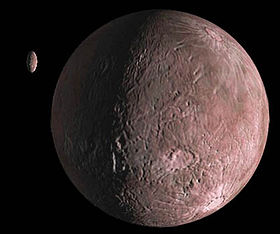- Weywot
-
Weywot 
Representación artística de Weywot (objeto pequeño) junto a QuaoarDescubrimiento Descubridor M. E. Brown Fecha 22 de febrero de 2007 Designaciones (50000) Quaoar I Weywot Nombre Provisional S/2007 ((50000) Quaoar) 1 Elementos orbitales Inclinación desconocida Semieje mayor desconocido Excentricidad ¿0? Radio orbital medio 95 ± 24 km Satélite de Quaoar (planeta enano) Weywot, Oficialmente llamado (50000) Quaoar I Weywot, es la única luna que se conoce del objeto transneptuniano Quaoar. Fue descubierto el 22 de febrero de 2007, basándose en imágenes obtenidas el 14 de febrero de 2006.[1] [2] El satélite fue descubierto a una distancia de 0.35 minutos de arco de Quaoar con una diferencia en su magnitud aparente de 5.6.[3] Orbita a una distancia de 14.500 kilómetros de Quaoar y tiene una excentricidad orbital de aproximadamente 0.14.[4] Asumiendo que su albedo sea igual que el de Quaoar, la magnitud aparente sugiere que esta luna tiene un diámetro de aproximadamente 74 km (1:12 de Quaoar).[4] Brown, su descubridor cree que es un fragmento del propio Quaoar fruto de una colisión, del cual especula perdió gran parte de su capa de hielo durante el proceso.[5]
Nombre
Al ser descubierto, Weywot recibió la designación provisional, S/2006 (50000) 1. Brown le dejó a los Tongva la elección del nombre, quienes seleccionaron el del dios Weywot, hijo de Quaoar.[6]
Referencias
- ↑ Daniel W. E. Green (22-02-2007). «IAUC 8812: Sats of 2003 AZ84, (50000), (55637), (90482)». International Astronomical Union Circular. Consultado el 2011-07-05.
- ↑ Wm. Robert Johnston (25-11-2008). «(50000) Quaoar». Johnston's Archive. Consultado el 26-05-2009.
- ↑ Distant EKO The Kuiper Belt Electronic newsletter, marzo 2007
- ↑ a b Brown, Michael E.; Fraser, Wesley C. (2010). «Quaoar: A Rock in the Kuiper belt». The Astrophysical Journal. http://arxiv4.library.cornell.edu/abs/1003.5911.
- ↑ Brown, M.E.; Fraser, Wesley (2009). «Quaoar: A Rock in the Kuiper Belt». DPS meeting #41. American Astronomical Society.]
- ↑ "Heavenly Bodies and the People of the Earth", Nick Street, Search Magazine, July/August 2008
Categoría:- Objetos transneptunianos
Wikimedia foundation. 2010.
